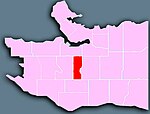G. F. Strong Centre
GF Strong Rehabilitation Centre is the largest rehabilitation hospital in British Columbia. It is located in the South Cambie neighbourhood of Vancouver. It provides inpatient, outpatient, outreach and clinical support services to clients/patients across British Columbia and the Yukon in four unique programs: Acquired Brain Injury, Spinal Cord Injury, and Neuromusculoskeletal. It also has specialized programs for adolescents and young adults. Health care professionals such physiatrists deliver individually tailored treatment for people with the most serious and complex injuries and illnesses requiring rehabilitation. The team caring for patients at GFS may include: Occupational Therapists, Physiatrists, Physiotherapists, Social Workers and Speech Language Pathologists depending on the patients needs. Recreational therapists, Music therapists, Art therapists and peer support workers are also important parts of the rehabilitation team.
Excerpt from the Wikipedia article G. F. Strong Centre (License: CC BY-SA 3.0, Authors).G. F. Strong Centre
Laurel Street, Vancouver
Geographical coordinates (GPS) Address Website External links Nearby Places Show on map
Geographical coordinates (GPS)
| Latitude | Longitude |
|---|---|
| N 49.247222222222 ° | E -123.12583333333 ° |
Address
GF Strong Rehabilitation Centre (G. F. Strong Rehabilitation Centre)
Laurel Street 4255
V5Z 2G9 Vancouver (South Cambie)
British Columbia, Canada
Open on Google Maps








